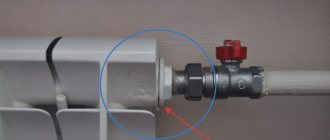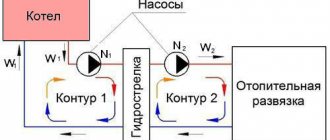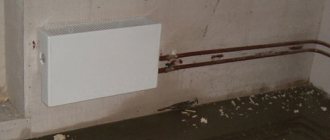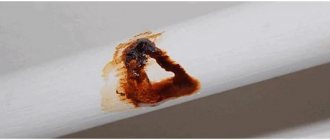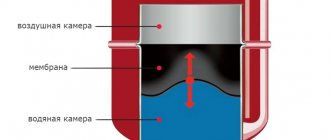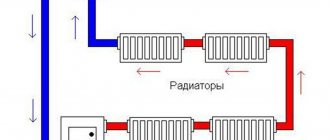When operating the heating system of a private home, there are unforeseen cases of leaks occurring in one of the sections of the main line. Leaks often occur in hidden places, so it is important to know how to detect a water leak in a heating system in this situation.
If a heating system leak occurs when using antifreezes that are colored in different colors, the task is simplified, but if the working fluid in the line is clear water (about 80% of cases), it becomes more difficult to detect the place of depressurization.
Help in the search are technical measuring instruments and special equipment, with the help of which it is easier to detect places of coolant leaks.
Fig.1 Heating equipment
Causes of leaks in the heating system
When solving the problem of how to find a leak in a heating system, it is useful to know the reasons for its occurrence - this will help to quickly and effectively eliminate the malfunction. There are quite a few reasons for depressurization of the heating main, the main ones being:
- Loss of tightness of connections. This is the main cause of leaks that affect all traditional water heating pipelines. They arise as a result of corrosion when using metal pipes, aging of sealing gaskets, and spontaneous unscrewing of threaded connections.
One of the common causes of leaks at joints is the thermal expansion of metals, while during operation of the heating system in a high-temperature operating mode, water does not leak, and after the coolant cools down, the metal of the fittings at the joints narrows and a leak may appear.
- Pipeline damage. If a steel line is used longer than its allotted life, water leaks out as a result of corrosion of the walls of the heating pipes, leading to their thinning. Synthetic materials can be damaged if installed incorrectly or during use. Mechanical damage to pipelines due to freezing, excess pressure or extremely high temperatures is also possible.
- Poor quality installation of the system. Poor welding in steel pipes, improper pressing of fittings into metal-plastic, installation of a line from plumbing fittings and pipes from different manufacturers - these factors often lead to leaks.
- Use of antifreeze. Non-freezing liquids have increased fluidity, their surface tension is less than that of water; if they are poured into the system after using a water coolant, leaks may appear at the joints.
- Poor quality materials. Sometimes heating radiators leak between sections due to poor quality manufacturing; leaks are caused by cheap fittings with short thread lengths or thin walls, defective Mayevsky valves on radiators or ball valves in the system.
- Violation of operating rules. If the heating system is operated incorrectly: a significant excess of pressure or overheating of the coolant, leading to destruction, wear and expansion of the pipeline and gaskets, a leak appears.
Rice. 2 Connection diagram for heating boilers, radiators and heated floors
Causes of leakage
It is important not only to detect a coolant leak in the heating system, but also to understand why it occurred. Situations in which the pressure gauge on the boiler may indicate low pressure are as follows:
- violation of the tightness of connections as a result of corrosion of pipes, wear of gaskets or loosening of threaded connections;
- thermal expansion and contraction of fittings. When the coolant reaches a certain temperature, the metal parts expand, but as soon as the water cools, the metal of the fittings narrows and begins to let liquid through;
- changing the coolant in the pipes. If water was first used and then you decided to pour antifreeze into the system, the seals may expand and then dry out;
- excess pressure in the heating system due to the expansion tank being too small. This can lead to cracks in the pipes.
In addition, leakage occurs as a result of improper installation or operation. This is especially true for metal-plastic lines, which are more sensitive to any violations of installation technology.
Where can leaks occur?
Pipes, plumbing fittings and appliances (boilers, radiators, expansion tanks) leak as a result of corrosion, aging gaskets or mechanical damage.
When using steel heating pipes, depressurized joints lead to leaks in couplings, drains (battery connection areas), bends, connection points for shut-off valves, heating and measuring instruments, pumping and water heating equipment. Similar problems arise when using a metal-plastic pipeline; in addition to the above, water can flow out after some time through the threaded connections of compression couplings as a result of their self-unscrewing.
Rice. 3 Search devices for detecting leaks in hidden pipelines
Expansion tank
Located in the attic. Since the attic is usually an unheated room, the tank must be insulated, otherwise the water in it may freeze in winter. The tank compensates for temperature fluctuations in the water level. In addition, sometimes water in the system can boil (this happens if you start heating the boiler too quickly), and the bubbles significantly increase the volume. This is what the excess volume in the expansion tank is for.
It is advisable to provide for the possibility of draining excess water from the tank when it overflows. To do this, water can be discharged either into the sewer or simply onto the street.
It should be borne in mind that water from an open system evaporates. Therefore, it is necessary to replenish the system with water. This can be done manually, periodically climbing into the attic and adding water, or you can make an expansion tank similar to a toilet - with automatic topping up of water.
But they rarely do this. Usually they just use a container.
It is better to close the top of the tank with a lid so that less water evaporates.
How to detect a water leak in a heating system
Any heating line in a private home is equipped with a pressure testing device - a pressure gauge, which is used for adjustment and control. Its readings correspond to the pressure in the system and must be stable - any deviation towards a decrease indicates depressurization and a possible coolant leak.
Typically, heating consists of several circuits (heating radiators, heated floors), and installing a pressure gauge in each of them allows you to determine the depressurized area.
If a leak occurs in an open pipeline located in the house, it can be detected by wet marks on the floor or walls; when using antifreeze, the stains will have a corresponding color.
How to find a leak underground or in a screed
As mentioned above, a pressure gauge allows you to detect a leaking circuit; finding a leak under a layer of earth or screed without special instruments is quite a difficult task. Since most problems occur at pipe joints, you should first open the screed or dig the ground in these places. The second option is to use special instruments (for this you can hire specialists or rent equipment), to detect breakthroughs they use:
- Thermal imagers . Using compact devices, you can immediately find a water leak in the house or underground if the pipeline is shallow. The depressurized area will have the appearance of a thermal blurred spot with an increased temperature at the place where the coolant leaks.
- Moisture meters . High humidity indicates that there is a leak in that area. The method is used only indoors, its effectiveness is low - it can only detect a room with high humidity, and not a specific area.
- Phonendoscope. Acoustic devices that capture sounds are more suitable for identifying external noise sources; with their help, it is very difficult to find a leaking area in the walls or screed.
Rice. 4 Finding leaks using thermal imagers
Leak Diagnosis
A regular sheet of paper will help you verify that there is a leak. To check, you need to turn off the hot water and wait for the coolant in the pipes to cool. With hot coolant, the leakage area will quickly dry out and the problem will not be found. Next, a sheet of paper is passed through the pipes, paying special attention to the joints. Where the paper gets wet and the leak needs to be fixed. This method is acceptable if the breakthrough occurred on a visible section of the highway. It is more difficult to identify it in a hard-to-reach place, in a “warm floor” system or underground.
Each heating system must be equipped with monometers, which will indicate leakage. If the pressure in the system decreases, the readings on the instruments will also deviate downward. It is recommended to install monometers on each circuit and monitor the presence of depressurization on each of them.
Only specialists using special equipment can diagnose leaks underground or in finishing:
- moisture meters - detects leaking pipes in walls or heated floors. Not used for checking underground communications;
- thermal imagers - helps to find a leak if the pipes are hidden shallowly and the coolant is at a high temperature. In the case of cold water and buried communications, the thermal imager will not be able to work;
- acoustic devices - detect leaks by capturing sounds.
A leak in a heating system can be found using a thermal imager.
The most difficult thing to determine is the location of a leak in a “warm floor” system, and especially if it is located under a screed. You can find the problem yourself using a simple method, but first you need to understand where the pipes go. To do this, the heating is turned on at maximum temperature, and the floor surface is generously moistened with water. The places where the contour turns are located will dry faster. They are outlined with a marker or pencil, and the area that takes the longest to dry is the intended breakthrough. The problem can only be resolved by disassembling the screed above the floor.
There are special devices on sale that automatically detect water leaks. They are not cheap, but they fully pay for themselves in operation. The device consists of sensors, valves and a control unit. The sensor sends a signal about a leak to the main unit, the valves are activated and shut off the water. Thus, the owner does not have to worry that he will flood his neighbors while he solves the problem of a breakthrough.
What immediate measures are taken if a leak occurs?
The appearance of a leak in the heating system requires an immediate response. The first measures depend on the nature of the problem and the location where it occurred.
A leak in a private house can be fixed on your own, but in an apartment you should be careful not to flood the neighbors living below. Another nuance is that during the renovation the entire riser will have to be shut off, which means that all the apartments it connects will be without heat.
You can try to fix a small leak yourself using improvised means. If the problem is serious, then shut off access to the coolant and call specialists.
Hot water splashing in all directions can cause injury, so before turning off the water supply, you must throw a thick blanket over the pipe or radiator. Valves for shutting off hot water can be located directly in the apartment, but most often they are located in the basement of the entrance. You'll have to go down there, find the right tap and turn it off.
What areas and elements can leak?
Leaks are most common in metal pipes. Elements that may be subject to destruction are the following:
- joints of pipes, adapters and seams;
- solid pipe;
- radiator;
- under the locknut;
- in the heated floor circuit;
- space between battery sections.
Leaks in the heating system often occur in radiators.
Most often, cheap polymer pipes are susceptible to damage. They break, leak, swell. Metal-plastic pipes are also susceptible to leaks if they were incorrectly selected. There are special products for heating systems. If pipes for cold water are installed in it, then under the influence of high temperatures they become deformed and burst.
Materials for repairing leaks
The selection of materials for repairing the damaged area is carried out depending on the location of the leak and the temperature of the coolant. All products must withstand both physical and temperature stress. The following materials are used for repairs:
- rubber elastic bandage - used to seal curved areas or fitting locations. The bandage itself is not able to withstand high water pressure in the pipes, so after screwing it on, it is necessary to screw the reinforcement on top or tighten the clamp;
- repair tape - suitable for sealing pipes, withstands pressure up to 35 atmospheres, temperature range from -70 to +370 degrees. The service life of the material is 50 years;
- clamps are metal clamps that can withstand pressures of up to 70 atmospheres and temperatures of more than 100 degrees. The clamps are designed for standard pipe diameters and are used only on straight sections of the pipeline;
- two-component compositions - epoxy resin or cold welding. Good for eliminating leaks in curved areas or in hard-to-reach places. Epoxy resin is best used in combination with binding materials (cloth, bandage, etc.);
- light-curing plastic - a kit that includes liquid plastic and an ultraviolet lamp. Under its radiation, the material polymerizes and hardens. Operates in the temperature range -40 – +150 degrees.
We recommend: Do-it-yourself induction heating boiler: how to build a homemade unit
All these materials are suitable for major repairs of depressurization. If there is nothing suitable at hand, then wooden choppers, cement coating, and various adhesive materials are suitable as temporary devices.
Such measures include:
- Protection of pipes from electrochemical corrosion. To do this, cathodic protection is performed and anti-corrosion agents are applied.
- High-quality water treatment. To slow down pipeline corrosion, the amount of oxygen dissolved in water is reduced.
- Periodic assessment of the residual life of pipes. Thanks to this, it is possible to promptly identify sections of the pipeline that need to be replaced. This can significantly reduce the risk of accidents and, as a result, reduce water losses.
Methods for eliminating leaks
Once the leak has been located and you have the necessary tools to fix it, it's time to fix the water leak in your heating system.
When the pipe is leaking
Pipe leaks are most often caused by poor-quality welds. A rubber gasket and clamp solve the problem. The pipe is thoroughly cleaned of paint, sealant is applied to the hole, and a gasket and clamp are placed on top. The bolts are tightened as tightly as possible to prevent future leaks.
In a bent section of pipe, the leak is repaired with epoxy resin or repair tape. The resin is applied only to a dry surface, so you will have to drain the water and systems. If you do not want to free the batteries from the coolant, it is better to choose tape.
- Before gluing, the pipe at the leak site and approximately 8 cm around it is thoroughly cleaned and degreased.
- The tape is soaked in water for 20 seconds.
- The hole in the pipe is wrapped with an acrylic gasket from the repair kit.
- The tape is wound diagonally, starting from the edge of the gasket, forming turns up to the middle of the hole.
- At the time of winding, the tape is pressed well against the surface for about 7 minutes.
- When the material begins to stick to the gloves, it is left to dry completely.
A rubber gasket and a clamp will help solve a leak in a heating pipe.
The time for complete hardening depends on the temperature of the pipe. At 20 degrees this is about half an hour.
When the radiator leaked
The leak could be the joint between the battery sections or the radiator plate. In this case, cold welding will be required. Turn off the water supply, first clean the damaged area, degrease it, and only then apply sealant to the hole and an area of 3-5 cm around it. The weld hardens quickly. After it has completely dried, turn on the heating.
Leaks between sections are more difficult to eliminate. To do this, the radiator is dismantled and the nipple connection is tightened tightly, applying maximum force. Upon completion of the work, the battery is mounted in place and water is supplied to the system.
When it leaks under the locknut
Before starting work, the water must be turned off and drained from the system. The nut is unscrewed, sealed with cloth or a special compound and tightened again. All sealing materials are wound clockwise. At the end of the work, open the riser and check the tightness of the connections. If the leak has not been eliminated, repeat the thread winding.
How to identify a damaged area
If the leak is slight, and the location of the leak in the heating system is not obvious at first glance, then it can be determined after turning off the coolant supply. They only check the cold system, because... Water evaporates quickly from heated surfaces. A piece of ordinary toilet paper or a dry white napkin will help with this.
When the system has cooled, slowly rub a piece of paper over the suspected leak site. Connections and joints are examined especially carefully. The place where the paper gets wet needs to be inspected and the hole found. The task becomes more complicated if the pipes are disguised under finishing materials, are located under the floor or in the ground.
Why do pipes wear out?
For the installation of heating systems in residential buildings and apartments, metal pipes and radiators are most often used. They are highly wear-resistant, have a long service life, and high heat transfer. But even the most wear-resistant structures have a limit of strength and lifespan.
Steel heating radiator
Most often, leaks occur on metal pipes and batteries. Possible causes of wear
:
- Aggressive coolant environment and external factors causing metal corrosion. This process occurs due to condensate entering hard-to-reach and unprotected areas and contributes to the gradual destruction of the walls.
- Factory defects - to protect yourself from purchasing such products, ask the seller for a quality certificate with a Quality Control Department stamp.
- Long service life and mechanical damage. No matter how strong the metal is, it cannot withstand constant increased physical and mechanical loads. The equipment is constantly under high pressure, so it gradually becomes thinner and wears out.
- Incorrect insertion, violation of threaded connections, installation technologies. The most vulnerable places where water leaks most often are welds, joints, threaded connections and the areas around them.
- Violation of the normal operating mode: the cause of a battery breakthrough can be excessive or, conversely, insufficient pressure in the system, as well as a violation of the operating mode.
How to fix a leak and solutions
How to repair a leak in a heating pipe depends on where it occurred: at the junction of sections, at the connection of the radiator with the pipe, on the pipe itself. Repairs are carried out in different ways, let's look at the main methods.
The heating pipe is leaking at the junction. Important! If it drips from the pipeline through which hot water is supplied for heating, and this section is under pressure, then the fistula can be eliminated for a very short time. In this case, you will have to call the emergency service and carry out major repairs.
Cold welding
As a rule, it is used at the junction of two battery sections and helps to temporarily close the damaged area. It is made using adhesive-sealant, which can be purchased at a hardware store. It has a special composition that crystallizes when it dries and fills the hole.
Applying “cold welding” to a metal pipe
- thoroughly clean the damaged area from paint and rust using a brush with metal bristles or sandpaper;
- degrease, alcohol, solvent, acetone are suitable for this;
- cut off a piece of sealant, knead with wet hands until smooth;
- press well into the damaged area on the heating radiator and smooth it out;
- until the composition hardens completely, it must be pressed tightly to the surface;
- Curing time is approximately 20-25 minutes, complete polymerization is after 3 hours.
We recommend: The actual service life of a gas boiler: what determines the service life of a floor-standing or wall-mounted boiler unit when used in the heating system of a private home
Advice! Be sure to wear protective gloves, as the sealant is a chemically active compound that corrodes the skin.
Cement-plaster cast
If a hole is found on the heating pipe or the junction of the battery sections, you can make a cement-plaster bandage; for this, prepare the following consumables:
- medical bandage, a piece of gauze or thin cotton fabric;
- alabaster (plaster);
- cement;
- bucket or basin with water.
Repairing a leak with a cement bandage
- dilute cement in water, mixing it with gypsum, the consistency should be like that of rich sour cream;
- take strips of fabric or bandage 25-30 cm long, soak in the resulting composition;
- wrap a cloth around the damaged section of the pipe;
- overlays are made until the bandage is strong and tight.
Application of clamp and rubber
If you notice a heating pipe leaking, you can apply a commercial or homemade clamp, as well as a rubber lining, as a temporary measure. If there is a factory-made clamp of a suitable diameter, it must be applied to the leak and secured tightly with a bolt. If you don’t have one on your farm, you’ll have to make the rubber pad yourself.
Advice! A bicycle tire, a thick household glove, a ball, or a rubber boot can serve as consumables.
- cut a rectangle from a piece of rubber that will be 2-3 centimeters wider than the hole, the length should be the same as the diameter of the pipe;
- wrap the cover tightly around the pipe, and secure the edges with wire or metal clips; you can make a wire winding along the entire length of the bandage.
Repairing leaks with rubber and a clamp
Welding Application
If a heating battery (not metal-plastic, but cast iron) is leaking in a house or apartment, welding will help eliminate the defect. It can be used anywhere on the radiator. Therefore, after you have made minor repairs yourself or shut off the water supply to the battery, call the emergency service or a private company that provides hot welding services.
Repairing a metal heating pipe using welding Tip! If you have a compact welding machine on your farm and you know how to use it, you can solve the problem much faster than the experts arrive.
Types of sealants
Each of the sealants is good for specific living conditions, but for repairing heating equipment, special sealants for heating systems are better suited.
In modern everyday life, a large number of products with sealing properties are used.
Based on their chemical composition, sealants are divided into the following main types:
- acrylic - unstable, do not tolerate temperature changes;
- polyurethane - elastic, have high adhesion to metals, resistant to corrosion and temperature;
- silicone - the most common type of universal sealants, retain elasticity and moisture resistance over a wide temperature range, and are durable.
When sealing leaks in metal elements of a heating system with silicone sealant, it is permissible to use only its neutral variety, but not the acidic one, since the acetic acid contained in the acidic sealant will cause active corrosion of the metal.
The use of adhesive sealant will replace the need to use other methods of sealing threaded connections.
Heat-resistant sealant for heating pipes is used for metal and polymer materials. This product properly fulfills its purpose - to prevent the penetration of moisture from damaged elements of the heating system. The sealing substance, which is a viscous mass, hardens quite quickly at the site of application and subsequently withstands high temperatures.
To seal threaded connections in modern heating networks, anaerobic adhesive sealant is used instead of flax tow and FUM tape. The environmental friendliness of such a sealant allows it to be used not only in heating systems, but also in plumbing systems.
Sealant for heating boilers is used to eliminate gaps in places where heat resistance of the material up to 1500°C is required.
Using this product, it is possible to seal cracks in heat exchangers and chimneys of boilers and furnaces. After hardening in the seams between surfaces of different materials (metal, brick, concrete), the substance retains its tightness.
The better liquid sealant for heating repairs
The increased heat resistance of some special sealants makes it possible to use them for prompt repair of heating boilers.
For heating repairs, it is not always possible to use external agents. What to do, for example, if the location of the leak cannot be detected because the house had hidden pipes and installed a heated floor? Will we really have to break down the walls and open up the floors? No, you don't have to! In such situations, a relatively new method of eliminating leaks is used - by pouring liquid sealant for heating pipes into the system. This sealant is also suitable for radiators when it is not possible to apply a clamp to a leak.
The fundamental difference between liquid sealants for heating systems is their ability to eliminate leaks not by applying to the damaged area from the outside, but directly from the inside.
In an emergency, it is permissible to pour sealant intended for car radiators into the heating system
The essence of this method is that when mixed with a coolant, the sealant remains liquid, and only upon contact with air penetrating into the system does it polymerize. Gradually hardening, the sealant clots are sealed from the inside of the crack exactly in those places where the integrity of the system is compromised.
Several types of liquid sealants for heating are produced, each of which is adapted to special conditions of use, in particular:
- the coolant is water or antifreeze;
- gas or solid fuel boiler;
- heating or water pipes.
You should not try to look for one universal sealant for your home heating system. It is better to purchase a specialized composition for the specific parameters of your heating system.
The most famous among consumers are liquid sealants for heating systems produced by the German company BCG. The use of these products is considered an ideal solution for eliminating hidden coolant leaks. When used correctly, liquid sealant does not pose a danger to heating boilers and does not cause damage to the circulation pump and measuring instruments.
Sealant for pipes and heating radiators must remain in the system for a long time. Once you add this sealant to your heating system, you can forget about leaks for several years.
We recommend: Open heating system and closed one - which is better and what to choose?
Sealants for closed heating systems eliminate pressure losses associated only with leaks in pipes and radiators, but are powerless in cases where the membrane in the expansion tank is damaged.
Instructions for repairing heating pipes
Among modern compounds for eliminating heating system leaks, sealants deserve special attention. These are special waterproof products. They will not save you if a large fistula appears, but they are quite suitable for eliminating minor damage in heating and water supply systems. Plumbing silicone sealant can last for years. It is advisable to buy it and cold welding just in case before the start of the heating season. Such tools will be useful in every home.
Describe your question in as much detail as possible and our expert will answer it
Steps to eliminate a leak with liquid sealant
Before you start sealing possible leaks in the heating system, you need to make sure that the expansion tank is in good condition.
The procedure for using liquid sealants to repair a home heating system may seem quite complicated. In some cases, clots of sealing fluid cause partial blockage and impede the movement of the coolant. Therefore, in order not to cause damage to the heating equipment due to your inexperience, it is better to invite a specialist. In any case, you need to study the instructions for using a specific type of sealant for radiators and strictly follow them.
Having decided to use a liquid sealant to fix a problem in the heating system, you need to make sure that:
- the reason for the pressure drop is precisely the leakage of coolant, and is not related to a malfunction of the expansion tank;
- the selected type of sealant for heating systems corresponds to the type of coolant in the system;
- The sealant is suitable for this heating boiler.
German liquid sealant BCG-24 is used to eliminate leaks in heating systems
When using liquid sealant for pipes and radiators, it is important to maintain the correct concentration. On average, its values range from 1:50 to 1:100, but it is advisable to determine the concentration more accurately, since the effectiveness of eliminating leaks can be affected by factors such as:
- coolant leak rate (up to 30 liters per day or more);
- the total volume of water in a given heating system.
If the volume does not exceed 80 liters, 1 liter of sealant will be enough to pour into the heating system. But how can we more accurately calculate the volume of water in the system? You need to calculate how many meters of pipes and what diameter were laid in the house, and then enter this data into one of the online calculators. To the resulting volume of pipelines, you must also add the passport characteristics of the volumes of all radiators and the boiler.
You can drain all the water from the system into a certain container, the volume of which is precisely known, and then fill the system again.
Preparing the heating system
- Dismantle or cut off all filters with taps so that they do not become clogged with a viscous solution of sealant for heating systems;
- Unscrew the Mayevsky valve from one radiator (the first one in the direction of coolant flow) and connect a pump to it (the “Baby” type);
- Start the heating system and let it warm up for an hour to a temperature of 50–60°C at a pressure of at least 1 bar;
- Open all taps on pipelines and radiators to allow sealant to flow freely through them;
- Remove air from the entire system, including the radiators and circulation pump.
If the air is not completely vented, it will begin to react with the sealant and cause it to thicken in places other than where it is needed to eliminate the leak.
Preparing the sealant
- You can also pour liquid sealant into the heating system using a hand pump for pressure testing. Drain about 10 liters of hot water from the system into a large bucket, most of which is used to prepare the sealant solution, and leave a few liters for subsequent flushing of the pump;
- Shake the canister (bottle) with sealant for radiators and heating pipes, then pour its contents into a bucket;
- Rinse the canister thoroughly with hot water so that all remaining sediment gets into the solution being prepared.
Solutions of sealants for heating systems must be prepared immediately before use so that the liquid does not come into contact with atmospheric air for too long.
Pouring sealant
Liquid sealant for heating systems must have time to mix with the coolant before it reaches the boiler, so it is more advisable to pour it into the supply:
- Introduce liquid sealant solution into the system using a pump;
- Pump the remaining hot water through the pump so that absolutely all of the sealant sediment gets into the system;
- Bleed the air from the system again;
- Raise the pressure to 1.2–1.5 bar and maintain the system operating cycle for 7–8 hours at a temperature of 45–60°C. This period is needed for the sealant to completely dissolve in the coolant.
The operation of heating equipment cannot be stopped for several days until the polymerization of the liquid heating sealant is completed.
If there is no expansion tank
The expansion tank for a home heating network is the second most important element (after the boiler). Water, when temperature changes, changes in volume. The volume inside the circuit is always constant, so an expansion tank is additionally connected to the circuit, where excess coolant can be diverted, i.e. acts as a compensator. Consequently, the RB is a safety device that prevents emergency situations - increased pressure, depressurization of pipes, etc.
The use of boiler equipment without an expansion tank is highly not recommended.
For stable operation, the pressure of the RB must correspond to the system volume, because when replacing radiators with pipes, the volume of coolant must be increased. At the same time, a too large RB will not maintain the operating pressure in the circuit.
The standard is an expansion tank designed for 120 liters of coolant in the circuit (typical two-room apartment). If the tank is too small, then the water will be discharged when heating and expanding the volume through a safety valve. When the boiler is turned off, when the liquid temperature decreases, starting the boiler will be impossible, because its volume, and, consequently, the pressure will be insufficient. In such cases, additional network feeding is necessary.

